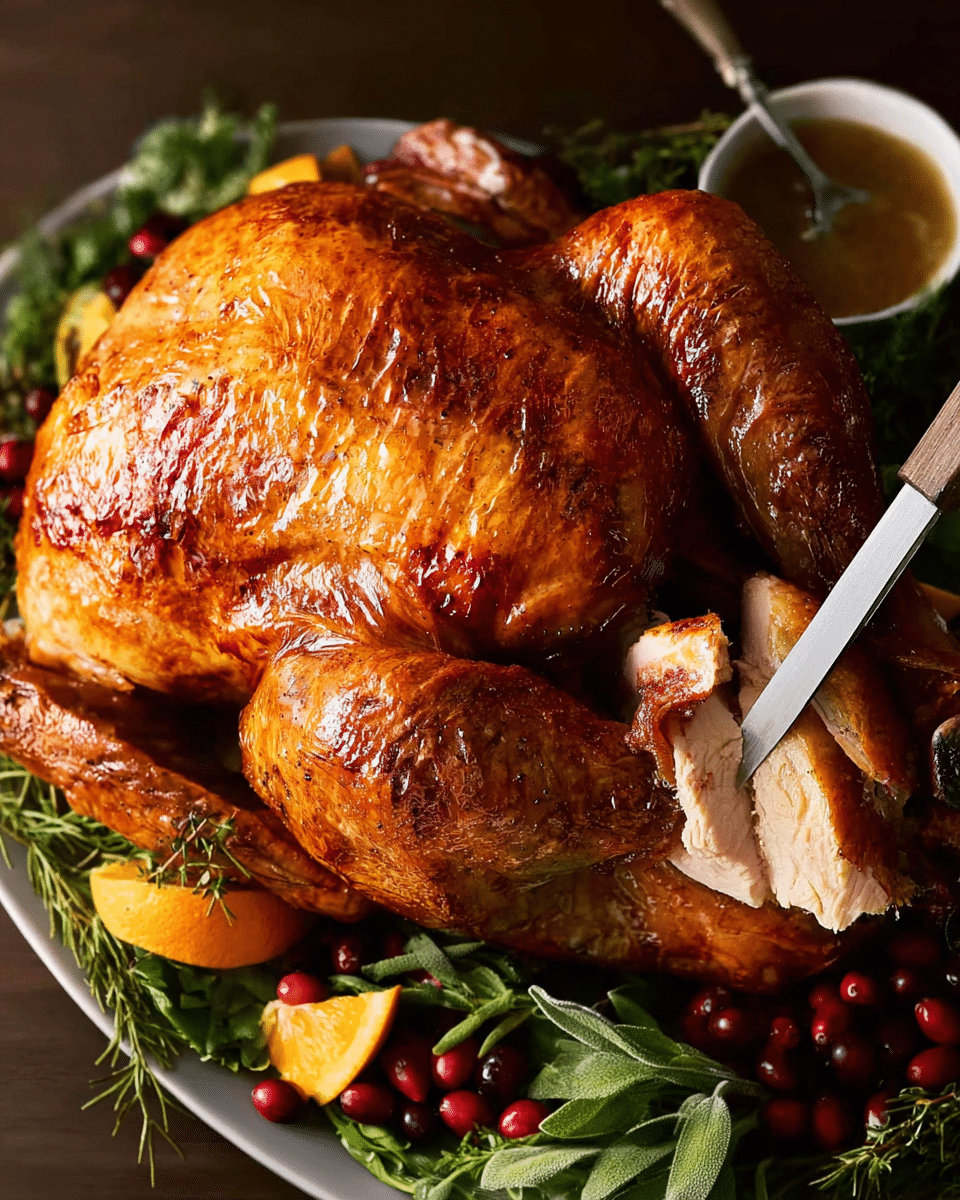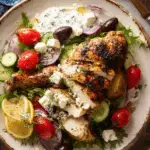The secret to holiday roast success? A dry brine that transforms your turkey into a succulent, golden showstopper. This technique involves rubbing a salt-based herb blend directly onto the bird and refrigerating for two days — no buckets, no mess, and incredible flavor. The result is crisp, golden skin and tender, juicy meat every time.
Finished with a brush of melted garlic-herb butter and roasted in stages for ultimate texture and moisture, this turkey is more than just your main dish — it’s the reason guests will request your hosting every year. Served with silky pan gravy or tangy cranberry sauce, it’s a centerpiece worth celebrating.
Full Recipe:
For the Turkey & Dry Brine:
-
1 whole turkey (10 lb / 5 kg), fully thawed or partially thawed
-
2 1/2 tbsp kosher salt
-
2 tsp dried thyme
-
1 tsp paprika
-
1 tsp garlic powder
-
1/2 tsp black pepper
For Roasting:
-
2 heads of garlic, halved horizontally
-
1 onion, halved (skin-on)
-
2 bunches mixed fresh herbs (sage, rosemary, thyme, parsley)
-
10 tbsp unsalted butter, melted
-
1 tbsp chopped herbs (sage, rosemary, thyme – equal parts)
-
3 garlic cloves, minced
-
1 1/2 cups dry white wine or water
-
Salt & black pepper to taste
For Gravy (Optional):
-
4 cups low-sodium chicken broth
-
5 tbsp all-purpose flour
-
Salt and pepper, to taste
Directions:
-
Dry Brine (2 days ahead):
Pat turkey dry. Mix salt, thyme, paprika, garlic powder, and pepper. Rub 1 tsp inside cavity, 1 tsp underneath, and rest all over the bird, focusing on the breast and under the skin where possible. Wrap tightly in cling wrap and refrigerate breast-side down. Flip after 24 hours. Unwrap 30 minutes before roasting. -
Prepare for Roasting:
Preheat oven to 425°F (220°C). Place garlic halves and onion in a roasting pan with a rack. Stuff turkey with herbs, garlic, and 3 tbsp melted butter. Tie legs together. Place turkey upside down on rack. Pour wine in the pan. -
Roast Phase 1:
Roast upside down for 30 minutes. -
Roast Phase 2:
Flip turkey using a towel. Reduce oven to 325°F (165°C). Brush with melted butter, sprinkle lightly with salt and pepper, roast for 45 minutes. -
Roast Phase 3 (Herb Baste):
Mix remaining butter with minced garlic and chopped herbs. Baste turkey, roast an additional 30 minutes or until internal temp reads 165°F (75°C) between thigh and breast. Cover with foil if browning too much. -
Resting:
Remove from oven, loosely tent with foil, and let rest for 30 minutes. -
Optional Gravy:
Place roasting pan on stove over medium heat. Add flour, stir for 2 minutes. Pour in broth, mash garlic/onion, scrape browned bits. Simmer 3–5 minutes until thickened. Strain and season.
Prep Time: 20 minutes | Cooking Time: 2 hours | Total Time: 2 hours 20 minutes
Kcal: ~425 kcal per serving | Servings: 10–12 servings
The Genius Behind Dry Brined Roast Turkey
Dry brining has revolutionized how home cooks and professional chefs approach roasting turkey. This method, once a secret of culinary insiders, is now embraced as a gold standard for achieving irresistibly juicy, flavorful meat without the hassle of buckets of salty water. The dry brined roast turkey featured in this recipe is a modern classic that combines time-tested technique with practical, no-fuss execution—perfect for Thanksgiving, Christmas, or any festive family gathering.
Dry brining involves applying a carefully balanced mix of salt and aromatics directly onto the turkey’s skin and allowing it to rest for 48 hours (or more) in the refrigerator. This process helps the salt penetrate deeply into the meat, enhancing flavor and improving moisture retention during roasting. The result? A perfectly seasoned, tender, and golden-skinned turkey that looks as good as it tastes.
Why Dry Brining is Superior to Wet Brining
Traditional wet brining requires submerging the turkey in a large bucket of salt water, often infused with herbs and aromatics. While effective, it poses several logistical challenges. You need significant fridge space, a waterproof container, and the patience to clean up inevitable spills. Dry brining, on the other hand, achieves the same (or better) results with none of the mess.
More importantly, dry brining enhances the natural flavor of the turkey. Instead of bloating the meat with water, it allows the turkey to reabsorb its own juices, concentrated with the salt and herbs from the rub. This intensifies the “turkey” taste while keeping the flesh moist and tender. Additionally, the pan drippings from a dry brined bird are less salty and perfect for making rich, savory gravy.
The Science of Juiciness
What makes dry brining work so well is its ability to restructure proteins in the meat. When salt is applied to the turkey’s skin, it begins to draw moisture to the surface. Over time, this moisture dissolves the salt and is reabsorbed into the turkey, breaking down muscle proteins and allowing the meat to retain more liquid as it cooks.
Because of this molecular change, dry brined turkeys not only roast faster than unbrined ones, but also stay juicy even if you slightly overcook them. This makes it a more forgiving method—ideal for both novice cooks and seasoned hosts managing multiple dishes in a busy holiday kitchen.
The Upside-Down Roasting Trick
One standout feature of this recipe is the use of the “upside-down” roasting method. For the first part of the roasting process, the turkey is placed breast-side down. This allows the rich juices from the dark meat to flow into the breast, naturally basting it and keeping it succulent. After about 30 minutes, the bird is flipped right-side up to finish cooking, allowing the skin to crisp beautifully.
This two-phase technique ensures even cooking and minimizes the risk of dry breast meat, which is often a challenge when roasting a whole turkey. When paired with dry brining, it guarantees an exceptionally moist and flavorful result.
Butter Basting with Herbs and Garlic
Another key element in this recipe is the generous use of garlic-herb butter applied during the final roasting stages. While butter is used throughout the roast for richness, the aromatic herb-garlic butter is added later to prevent the herbs from burning.
This finishing touch adds layers of flavor, scent, and color to the final presentation. Sage, rosemary, and thyme are the herbs of choice—timeless and aromatic, evoking all the best flavors of the holiday season. Combined with garlic and golden, bubbling butter, the surface of the turkey becomes crisp and beautifully browned.
Time Management and Planning Ahead
One of the best aspects of this dry brined roast turkey recipe is how well it fits into a holiday timeline. The brining process is spread over two to three days, allowing you to get a significant portion of the work done before the big day. With this method, you’re not rushing to season or prep the turkey hours before your guests arrive. Instead, most of the flavor development happens in the days leading up to your celebration, freeing up time for other tasks.
On roasting day, the process is straightforward and stress-free. You’ll spend minimal time fussing over the turkey once it’s in the oven, allowing you to focus on sides, desserts, or simply enjoying time with loved ones.
Gravy Worth Saving
Pan drippings from this dry brined turkey are pure gold. Since the brine doesn’t introduce excess salt or water, what you collect at the bottom of your roasting pan is a concentrated mix of natural juices, butter, garlic, and wine—a perfect base for a silky, flavorful gravy.
Rather than resorting to boxed gravy or last-minute improvisations, this method gives you a foolproof way to create a gravy that complements the turkey without overwhelming it. Whether you strain it for a smooth texture or leave it rustic with bits of garlic and herbs, the gravy becomes a highlight on its own.
Serving and Presentation Tips
Presentation is key, especially during a festive gathering. Even if you carve the turkey in the kitchen before serving, showcasing the whole roasted bird at the table—just for a moment—makes a statement. A simple garnish of fresh herbs, orange wedges, and bright cranberries adds color and elegance without much effort.
If you’re looking to impress guests visually, consider placing the turkey on a bed of leafy greens or watercress. The deep green creates a dramatic contrast with the golden, crispy skin, giving it that perfect holiday magazine look.
Carving Confidence
Carving a turkey can be intimidating, but once you’ve rested the bird properly (for at least 30 minutes), it becomes much easier. Letting the turkey rest ensures the juices redistribute evenly, resulting in less mess and more moisture in each slice.
Start by removing the legs and thighs, followed by the wings, then slice the breast meat crosswise for optimal tenderness. If you’ve brined and roasted it as directed, you’ll find the knife gliding through effortlessly.
Perfect for Leftovers
One of the hidden benefits of a dry brined turkey is how well it keeps. The seasoned meat stays juicy even after a few days in the fridge, making it ideal for sandwiches, salads, soups, or even pies. You can repurpose the leftovers in a variety of dishes—from turkey enchiladas to pot pies to hearty soups with barley or wild rice.
Because the flavor is already built into the meat, leftovers don’t taste like “second best”—they’re just as enjoyable as the main event.
Conclusion: A Foolproof Feast Centerpiece
Dry brining might sound fancy, but this method is all about simplicity, practicality, and unbeatable results. Whether it’s your first time roasting a turkey or your fiftieth, this dry brined version delivers on every front—juiciness, flavor, crispy skin, and presentation.
With the added convenience of fewer prep-day tasks and more consistent results, this technique is perfect for those hosting large gatherings or just wanting to ensure a stress-free, show-stopping meal. When done right, dry brined roast turkey becomes more than a recipe—it becomes a holiday tradition your friends and family will request year after year.






